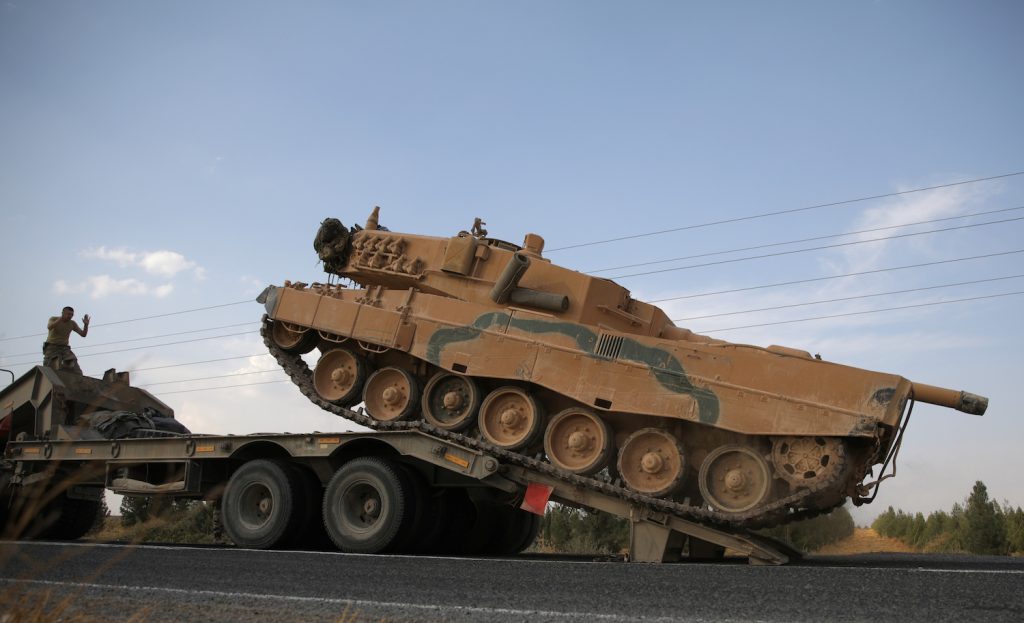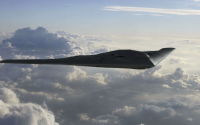
Prospects for US-Turkish convergence on Syria

Syria has been a point of deep contention in US-Turkish relations for the past decade, despite the fact that the two NATO allies have cooperated on diplomatic pressure campaigns against Bashar al-Assad’s regime, humanitarian relief, and refugee assistance. History offers relatively few examples of two countries committed to the same outcome of a war but largely incapable of cooperation within it. In fact, the two are fighting parallel wars in Syria—the Turks against forces affiliated with the Kurdistan Workers’ Party (PKK) terror group (the People’s Protection Units, or the YPG), the Americans against the Islamic State (IS) using those same affiliates—with neither effort focused on the mutual opponent (Assad and his sponsors). Is there any prospect for change in this odd equation?
A rift opens up
The war in Syria has grown into a major wedge between the United States and Turkey. Many Turks believe that Washington wants to erect a PKK-aligned state in Syria, and many in Washington believe Turkey has been insufficiently focused on eradicating Sunni extremism. Yet it was not always so; once upon a time there was a sense of shared purpose. National leaders from both countries demanded Assad’s ouster at the outset of the war. Turkish President Recep Tayyip Erdoğan pledged Turkish support should the United States impose a no-fly zone and saw general overlap on Syria with then US president Barack Obama.
Obama came to view the war as more about the IS than Assad, his support to the Syrian opposition evaporated and the war became overwhelmingly a matter of counterterrorism policy. The United States and Turkey each demurred from new military commitments while urging the other to take the lead. Between the fall of Mosul to the IS in 2014 and the fall of Aleppo to Assad in 2016, the United States exited the war against Assad and refocused on the war against the IS; this removed the common, if tenuous, shared political logic.
Unwilling to commit large US forces to Syria and disappointed in hopes that Turkey might, Obama in 2014 struck a bargain of “naked practicality” to support the PKK-aligned YPG. While the move was billed as “temporary, transactional, tactical,” its open-ended nature constituted a “ticking time bomb” by disregarding Turkish concerns over empowering PKK networks. Over time, some in Washington came to think that a rebranded YPG might be able to create an autonomous Kurdish region on the cheap, analogous to the Kurdish region in Iraq and useful as a long-term platform for US forces. The YPG seemed to offer what had eluded Washington for a generation: effective counterterrorism without the need for state building or a political theory of success.
A multiaxial proxy game
It became clear after 2014 that the YPG’s ambitions extended beyond the defense of Kurdish-majority areas right up to security and political control over northern Syria and a key role in shaping the political future of Syria. This comported with the broader PKK project of carving self-ruled regions out in Syria, Turkey, and elsewhere under a common ideological banner. Because the US “by-with-through” operational approach abjured strategic control over the YPG while arming and equipping it, the United States became a de facto sponsor of that project.
The Euphrates River became a proverbial Rubicon in 2016 when YPG forces crossed it and remained in control of Arab-majority areas, despite US assurances of withdrawal. This proved to be a watershed moment for Ankara, as the Turks adopted an increasingly militarized approach to strengthening the anti-Assad opposition and rolling back YPG gains. A series of Turkish military operations in Syria eviscerated the YPG’s ambitions for autonomy, leaving them much-reduced territory and growing dependence on Damascus. Yet they retained a singular strategic asset—massive US military aid and a free hand in local and regional politics.
Northern Syria has become a region of intricate balances and overlapping conflicts. The Turkish-supported Syrian National Army (SNA) and the US-supported Syrian Democratic Forces (SDF, the core of which is the YPG) skirmish and spar uneasily while Ankara contemplates further action against the YPG. The SDF works with Assad’s forces in some places, claiming official status under Assad, while the United States provides its salaries and logistical support. Turkish and Russian forces conduct joint patrols in sensitive areas. Iran-backed militias target US bases in the east, while YPG and Iran-backed militias confront the SNA in northern Aleppo.
Meanwhile, SDF forces appear increasingly enmeshed in the struggle for control of the neighboring Kurdistan Region of Iraq (KRI). The YPG’s parent organization, the PKK, has come into open conflict with the Kurdistan Democratic Party (KDP), which the United States and Turkey support, while parlaying the weakening of the Patriotic Union of Kurdistan (PUK) into greater control of Iraq’s border with Iran. Meanwhile, highly trained elite counter-terror units (YAT) from the SDF have been operating in PUK-controlled Iraqi territory using PUK helicopters, likely with the knowledge of US forces. Even as Iran instrumentalizes the PKK to undermine the KDP, the PKK appears to be instrumentalizing the SDF to support its drive to supplant the KDP. The US war against the IS has morphed into something else—a multiaxial proxy game with no clear end game and multiplying side effects—and the biggest beneficiary may be Iran, in Syria as well as Iraq.
A narrowing path
Turkish commitment to prevent a PKK-aligned entity from ruling northern Syria or northern Iraq has been amply demonstrated. Washington, too, seems committed to keeping troops in Syria, less for a clear political goal than to prevent any other power from filling in when they leave. The modus vivendi of simply staying in Syria but out of one another’s way satisfies no one (not even the YPG). Are there ways to find convergence between the respective national policies, other than one or both parties exiting Syria and leaving it to Assad and the Iranians?
One theoretical path would be the YPG and its political wing, the Democratic Union Party (PYD), renouncing the broader PKK movement and its armed campaigns against Turkey. This could result in the movement being seen as authentically Syrian, and cooperating with the Syrian opposition in negotiations to end the war. Yet YPG fighters consider themselves inextricably linked to the PKK and its ideology, rendering distinctions more cosmetic than substantive. Further, the US interest in sustained use of the YPG as a counter-IS force requires continued arming and training that by definition poses a threat to Damascus, Ankara, and other Syrians, making reconciliation unlikely. The PKK uses the YPG as connective tissue to the Assad regime, and PKK-appointed commissars or “kadros” in Syria ensure that key decisions taken by the YPG or PYD comply with the political line set by the PKK’s senior leaders. The United States lacks the means, or the will, to reform the PKK control mechanism to placate Ankara or promote power sharing with other Syrians.
Former US Syrian envoy James Jeffrey argued that a reasonable compromise for Ankara and Washington lies in physical separation between Turkish-backed groups and the SDF, with consistent efforts to address specific Turkish sensitivities. Yet how long can the United States keep nine hundred troops on Syrian soil while they are subject to increasing attacks from Iranian proxies and there is no discernible end state? Other observers have argued that the time has come to negotiate with Moscow and Damascus a US withdrawal that returns nominal control to Assad but maintains SDF control in fact. It is hard to conceive of a more blatant repudiation of US values than to reward, and trust, Assad as guarantor of what follows.
The path forward
One obstacle to the United States simply declaring victory and leaving is al-Hol and prison camps like it. These camps hold tens of thousands of IS members, supporters, and relatives, and the SDF guards them; US withdrawal would likely lead to their release. In a sense, the United States is prisoner to the prisoners; with fewer IS targets in SDF-controlled areas, preventing a new wave of IS attacks by keeping IS members in prison has become a key measure of “enduring defeat.” The assumption of this contingent form of stability that outside actors—Turkey, Iran, Russia, or Damascus—will refrain in perpetuity from disrupting it appears tenuous.
US forces will depart Syria in the coming years, and the YPG and its political wing lack the resources and legitimacy to maintain control of majority-Arab northeast Syria on their own. A reasonable political strategy for the United States must recognize that protecting US geopolitical and humanitarian interests, as well as effective counterterrorism, in the long run rest more on cooperation with Ankara and Erbil than on propping up the YPG. A soft landing of sorts for those that fought the IS with the United States should be part of the strategy but can only be achieved if Ankara and Erbil receive assurances that the massive US military subsidies and political license granted the movement will be removed, forcing it into compromises with them, rather than with the United States’ enemies in Tehran and Damascus.
In short, the United States might signal an off-ramp from the YPG to Ankara and Erbil while incentivizing authentically Syrian components of the YPG and PYD to seek peace and political cooperation with the Syrian opposition—and with the KDP. Ironically, the best protection for US interests in Syria may rest in building down the power of its current proxy in a deliberate and transparent manner and negotiating a new relationship between it and our other friends in the region. This is no mean task but offers much-needed clarity to all sides. The alternatives of propping up an unsustainable status quo or matchmaking between the YPG and Assad, whatever their other results, will perpetuate the deep Syria rift in US-Turkish relations.
Rich Outzen is a geopolitical consultant and nonresident senior fellow at the Atlantic Council IN TURKEY with thirty-two years of government service both in uniform and as a civilian. Follow him on Twitter @RichOutzen.
Image: Turkish army tank is being unloaded on a road near the Turkish border town of Ceylanpinar, Sanliurfa province, Turkey, October 18, 2019. REUTERS/Stoyan Nenov

